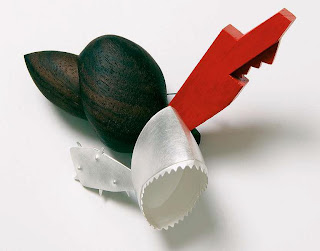One of the most important
international events pertaining to contemporary jewellery is Schmuck, an annual, specially curated
show coinciding with the International Trades Fair in Munich, Germany. Besides
trying every year to have enough really innovative work on hand to apply for
the show, I always look forward to the catalogues of Schmuck, for they are a rich source of stimulation and inspiration
on various levels. The catalogue for 2012 proved no different.
This year’s selection for Schmuck was made by Viennese jewellery
collector Dr. Karl Bollmann, who mentions the following in his curatorial statement:
“Anyone who thinks jewellery is essential, more than a reflection of vanity,
elitism and exploitation, is bound to have doubts. Was Kant right to say that
jewellery was detrimental to true beauty? Isn’t any attempt to embellish the
personality a striving for false appearance? Can and should externals reflect
the inward person?” The collector goes on to clarify: “I took on the task of
making this [jewellery] selection because I wished to find out, perhaps one
last time, whether jewellery that has substance, exists. If it did, it would
express something of universal validity” (Schmuck
2012. Munich: Gesellschaft für Handwerksmessen).
This got me thinking..… To me, the
notion of a “universal validity” of jewellery, or then the possible lack
thereof, is an interesting and challenging question, not least because I am a
jeweller and like to think of my work as having some validity. When, why and to
whom would jewellery be essential? What would “essential” mean in this context?
Is jewellery, or any other form of adornment or embellishment, really only an
attempt to falsify appearances, or is it an attempt to externalize something
internal?
Before attempting to formulate an
opinion on the above, I should probably mention that I tend to engage with this
question from the perspective of the maker or the artist, and not necessarily
the wearer, for I do not generally wear jewellery. Why, you ask? Mostly out of
habit – when working physically in a studio it is not practical to wear
jewellery, and so, over the years, I have come to know myself as ‘unadorned’.
Thus, from the perspective of the
maker, I tend to agree with the following notion by influential artist jeweller
Fritz Maierhofer: “is it not true that one of the origins of art lies in what
we have trivialized as ‘self-adornment’, the first form of individualisation
which brings us to maturity as complete beings?” (Koschatzky, G. & Aigner,
C. (eds). 2006. Fritz Maierhofer –
Jewellery and more! Stuttgart: Arnoldsche). Whilst I observe around me that
wearing jewellery is a means to individualize
and complete the Self, as an artist jeweller I strongly feel that creating jewellery makes me a more
complete being. To me, creating jewellery is a means to investigate and reveal
the internal structures and invisible dynamics of the Self and, perhaps more
so, an attempt to communicate my existence as a human being in a sincere,
truthful manner, which happens to be visual and tangible.
Bollmann in a way echoes this notion of
self-communication in his summary of the jewellery he was presented with:
“everything was represented, everything that could be thought and felt, and
that never ceases to be thought and felt around the world” (Schmuck 2012. Munich: Gesellschaft für
Handwerksmessen). All of the pieces Bollman engaged with represented for him
something that essentially spoke of being human, which referred to the
intellectual and emotional capacities of human beings, two of the perhaps most
defining attributes of being human.
Every Schmuck artist communicated his/her existence as a human being
through his/her work, and inevitably so, I believe. For in creating (which is
always in some way related to making oneself vulnerable, exposing oneself), we
bring our history, baggage, hopes, fears, thoughts, emotions, opinions,
strengths and weaknesses to the table, consciously or not. We acknowledge,
celebrate, question, interrogate, humour, encourage and portray what it means
to be human. Even our choice of medium refers to something inherently human: by
choosing jewellery as a means of expression, the body, or at the very least the
presence of another being, is brought into the equation. By inviting, reaching
out to or perhaps even relying on somebody else to partake and share in our
creative expressions, we arguably reveal another essential aspect of being
human, namely that we are not islands.
Perhaps, then, it is safe to propose
that as long as every creative is completely true to him/herself within his/her
creative context – being courageous in the earliest sense of the word, namely
‘telling the story of who one is with one’s whole heart’ (Brown, B. 2010. TED
Talk: The power of vulnerability
[Online])- (s)he cannot but “pull the strings” of another human being; our
creations cannot but gain some degree of universal validity. Does that then not
give jewellery its essential quality, for both maker and wearer?
“everything that could be thought and felt, and that never ceases to be
thought and felt around the world”
Kim
Buck
»Pumpous II«
Ring/ring, 2011
Feingold, montiert, gepresst
Fine
gold, assembly and pressure
50x40x20mm
Schmuck 2012. Munich: Gesellschaft für
Handwerksmessen, p 32.
Shunho Cho
»Thorn
(inside)«
Brosche/brooch,
2011
Silber,
Holz, Acrylfarbe
Silver,
wood, acrylic paint
130x125x70mm
Schmuck 2012. Munich: Gesellschaft für
Handwerksmessen, p 34.
Ursula Guttmann
»Escapade«
Halsschmuck/necklace,
2010
Silikon/silicone
700x350x10mm
Schmuck 2012. Munich: Gesellschaft für
Handwerksmessen, p 39.
Kazumi Nagano
Brosche/brooch,
2011
Bambus,
Nylon, Gold
Bamboo,
nylon, gold
110x900x50mm
Schmuck 2012. Munich: Gesellschaft für
Handwerksmessen, p 62.
Carine Terreblanche
»Round
and round«
Ring/ring,
2011
Holz,
Email/wood, enamel
60x60x20mm
Schmuck 2012. Munich: Gesellschaft für
Handwerksmessen, p 82.






No comments:
Post a Comment